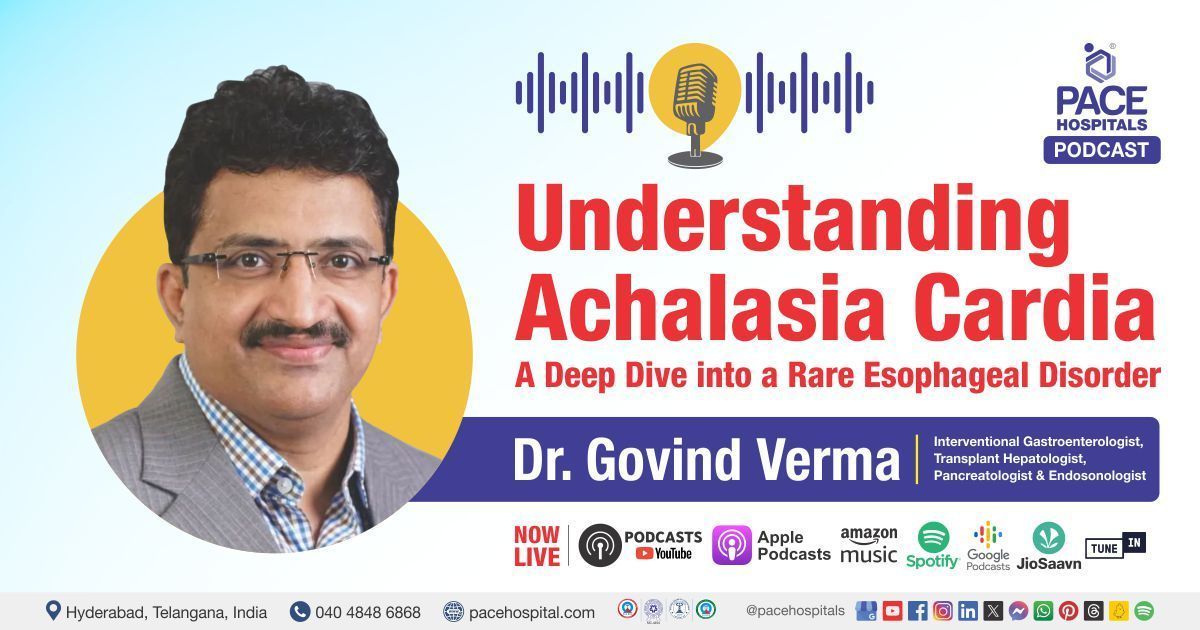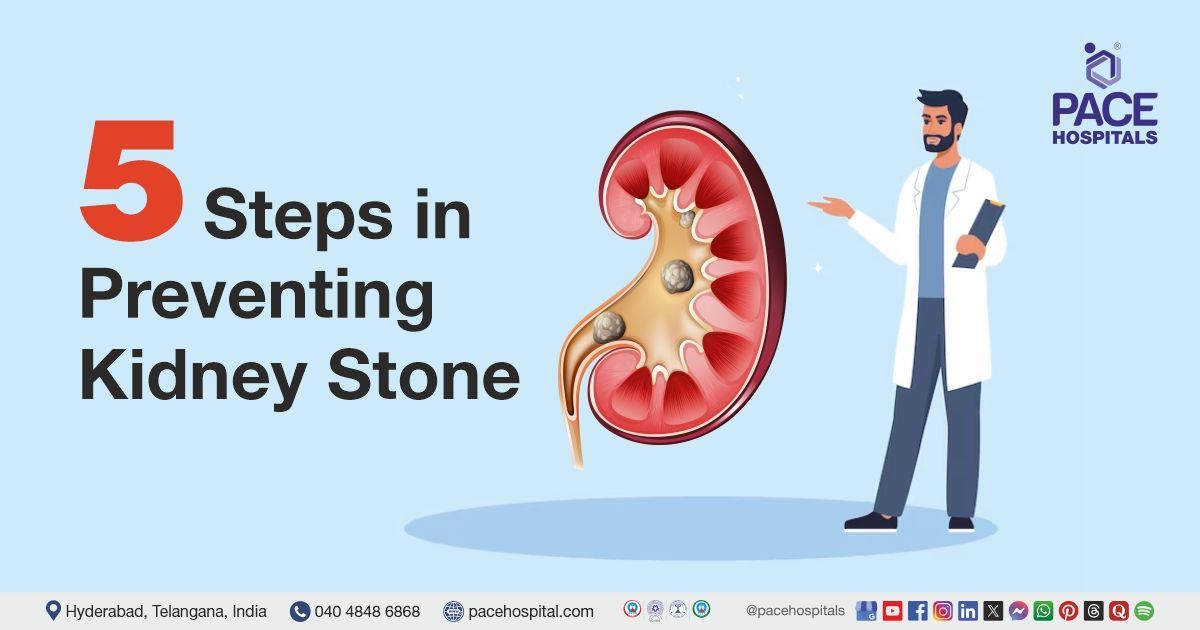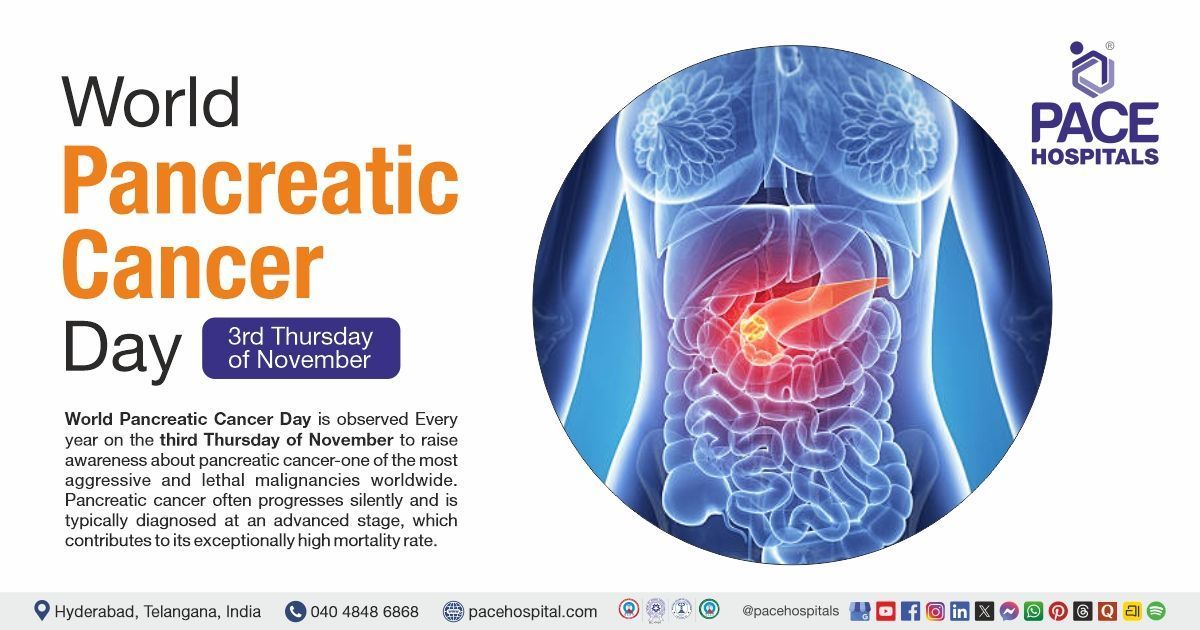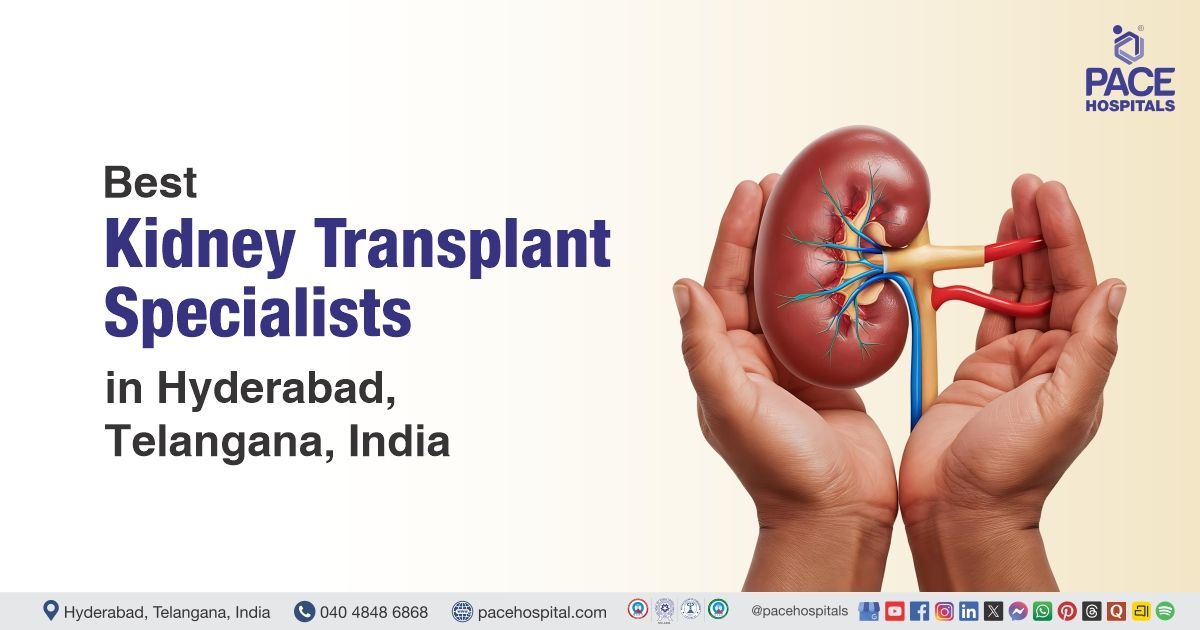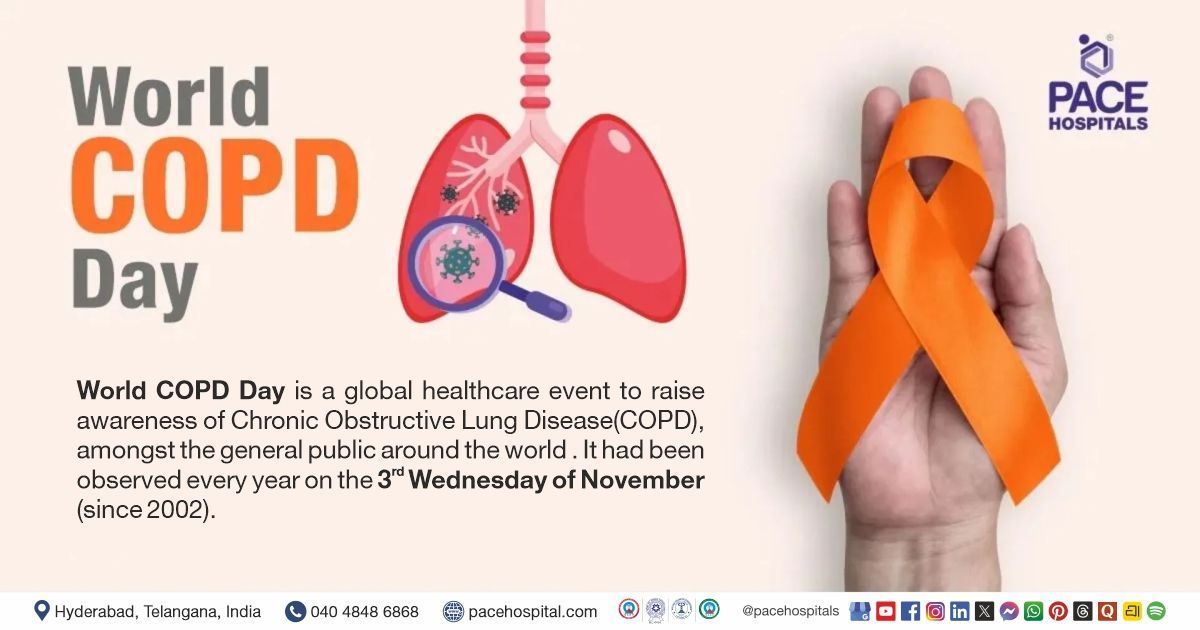Understanding Achalasia Cardia: A Deep Dive into a Rare Esophageal Disorder
PACE Hospitals
Listen to
Transcript
Host: Hello and Welcome to PACE Hospitals Podcast, today we’re diving into a condition that affects the esophagus, causing significant challenges for those diagnosed with it.
Joining us today Dr Govind Verma - Interventional Gastroenterologist, Transplant Hepatologist and Endosonologist having wide expertise in treating and managing achalasia cardia.
In today's episode, he would like to delve into the causes, symptoms, diagnosis, and treatment options for Achalasia Cardia, a rare esophageal disorder that affects swallowing and digestion.
Dr Govind Verma thank you for joining us at PACE Hospitals, Hitech City.
Dr Govind Verma thank you for joining us and lets understand exactly what is Achalasia Cardia and What are the underlying causes or contributing factors to the development of Achalasia Cardia?
Doctor: As we know, Achalasia Cardia the name itself signifies A is no and cardia is basically relaxation. So basically, it's a failure of relaxation of lower esophageal sphincter is an achalasia cardia. Now why there is a failure in relaxation of lower esophageal splinter? What is the reason for an enclosure? There is something which is not known so far, but what exactly happens in achalasia cardia patient is denervation of lower esophageal splinter, that means that there is absence of ganglionic sales in the lower cervical Splinter leading to loss of nerve supply and ultimately leading to failure to relax the lower esophageal splinter.
Why I'm talking about it, because as you know, when the patient tries to swallow normally esophageal muscles Contract, that is called as peristalsis with that peristalsis, the food goes down and reaches to the junction of food pipe and stomach, which we have a one wall there we call it as lower esophageal splinter, so that splinter lower esophageal splinter doesn't relax in a patient of an Achalasia cardia, whereas normally when the food reaches with the propulsion and peristalsis is down to lower esophageal splinter filter this wall opens and the food goes down. Into the stomach, but whereas in an achalasia cardia patient, this lower esophageal splinter, fail to relax. Leading to obstruction to the passage of food from the esophagus or food pipe to the stomach.
Host: What are the most common symptoms experienced by individuals with Achalasia Cardia?
Doctor: Most commonly, the patient presents with difficulty in swallowing. We call it as dysphagia more common with liquids than solids ultimately, but it can lead to both. Other symptoms which will be present are weight loss because of the unable to eat food, there can be there can be a putrid smell or bad breath, there can also be patient may present with retrosternal chest pain or we call it as atypical chest pain which is relieved by pressing over the chest or back, or by pushing the water down the food can sometimes go down and some patient can present with cough or, aspiration of food by content into the lungs, called as aspiration pneumonia.
Host: So, Doctor Could you explain the specific diagnostic test used to confirm Achalasia cardia?
Doctor: Achalasia cardiac can be diagnosed as it is a motility disorder of esophagus as we know by doing the specialized test called as esophageal manometry. Esophageal manometry basically tells you about 2 things. One is how is the peristalsis of the food pipe, and second is what is happening to the lower esophageal splinter whether the pressure is high or low, and whether it is in a state of contraction or not.
So, by doing a social manometry, we would know that, Is there peristalsis there or not, if there is no peristalsis returning Achalasia cardia, we also would know whether the lower esophageal splinter is in a state of contraction or it has a high pressure there again, it goes in favour of Achalasia cardia.
This is just a brief overview I am trying to view. There are 3 types of Achalasia cardia which are defined based on insufficient manometry. So, what is a sufficient manometry? Basically, a small catheter which is placed through the nose, into the food pipe up to the lower end and then patient is asked to make serial atoms of swallows which are dry and wet swallows and during this swallows and recording is made on the computer on a prefixed of software and in that we can come to know the entire movement of. Food pipe, which we call as peristalsis. We can notice the pressure in the food pipe, and so on, and that is how the manometry studies are being done.
The second investigation, which is done old age but still valid because we come to know about anatomical finding of a full pipe, is barium swallow. When we do a barium swallow. Ask the patient to swallow a barium which is on white liquid, and then we take serial X-rays. A patient who has achalasia cardia, we will have a classical bird beak sign, It's like a bird beak at the lower end of its Vegas because it is narrowed and in a state of contraction, it doesn't relax, so it looks narrower, and then approximately there is a dilatation of the Esophagus, so it's called as bird beak capellans.
Apart from that, we also come to know about size of the like. We call Sigma Esophagus, diverticula which is there in the Esophagus and sometimes you may have inflammation of esophagus, which can be picked up and can be diagnosed.
The 3rd investigation is an endoscopy by doing an endoscopy. What we come to know is that whether there is a resistance at the lower esophageal sphincter or not, how is the peristalsis which we can notice while doing an endoscopy we can also know the whether there is an esophagitis or there is an inflammation of lower end of esophagus because of retained food, which is not going down because of the failure to relax of esophagus Sprinter food remains in the histories of a gas. Food remains in the food pipe and that infects and causes of allergies, which can ultimately lead to esophageal cancer. So, it is very, very important that we diagnose this condition as early as possible to prevent further complication.
Host: In what ways can Achalasia Cardia be treated and managed?
Doctor: Right from start, the treatment has been evolving and we are witnessing the 20th century, which is state of the art treatment modalities have come initially the gold standard of treatment was being a balloon dilatation wherein a balloon is inserted through the scope at the junction of the food pipe and stomach esophagus Sprinter. We inflate the balloon under endoscopic and fluoro guided, and we basically dilate that splinter with the control radial expansion when we call it as CRE, leading to relieving of the symptoms, but the problem with the balloon dilatation is that there is a risk of recurrence after one year in 60 to 70% of the cases.
So, the science has evolved, and then the second modality of treatment has come, which is. Laparoscopic helas myotomy, wherein we by the laparoscopic surgery method we cut the muscle fiber up to one to 2 centimeter from the G junction that is thereby relaxing the splinter and then helping in patients of achalasia cardia for the for the treatment, but what about those patients we have type one and type 3, where there is a longitudinal muscle is completely involved in that case, laparoscopic approach may not be that useful, in that case, the new modality of treatment has come, which is called as poem, which is per oral endoscopic myotomy where in with the endoscope, nowadays we can do a flexible endoscopic surgery. We can go into the esophagus, different layers in the wall of the esophagus, we call it as submucosal tunnel formation, and from the submucosa we go down and cut the longitudinal circular muscle and go down till the stomach. Proximal stomach and open this muscle wall by cutting this muscle wall, we open this sphincter and thereby helping the patients in preventing the dysphagia.
So basically poem has evolved and stood the test of time, and it is the first line of treatment for patients who have an achalasia cardia the advantages of poem are that we can treat all types of achalasia cardia type one, type 2, type 3. Although it is useful more for type one and 3. It also can be done as a short stay procedure it has Got other the advantage that it is has no scar, no incision made on the body. It is endoscopic surgery and that's a state of art and the results are very promising in patients who are getting treated with the achalasia cardia.
There are few general guidelines which we tell the patients who have an achalasia cardia tha,they should not take hard foods like nuts, bread, Dochlas and those substances which has hydrophilic properties which swell up and then can lead to more relapse of the symptoms.
So, whatever it is basically in Achalasia cardia is motility disorder disorders of esophagus, which is usually diagnosed very late because of less awareness among clinician and among paths and usually, the high-end investigations are not available at all centers like esophageal manometry and endoscopy. So, before they can get diagnosed, it's it takes years together before they get treated by an expert. Thank you.
Host: Thank you Dr Govind Verma for sharing crucial information regarding the Achalasia Cardia to our listeners.
If any of you have any further questions regarding achalasia cardia please don’t hesitate to consult a gastroenterologist, Remember, knowledge is power when it comes to understanding health conditions like Achalasia.
We will see you soon on PACE Hospitals Podcast with another episode until next time, stay informed, stay proactive, and take care of yourselves. Thank you.
Achalasia Cardia is a rare esophageal condition characterized by the lower esophageal sphincter (LES)'s failure to relax during swallowing, as well as decreased peristalsis, the regular contractions that drive food down the esophagus and into the stomach. This leads to difficulties with swallowing, regurgitation, chest pain, and, in certain instances, weight loss.
Living with Achalasia can create substantial difficulties. Simple activities, e.g., eating a meal with family or friends, can become stressful and uncomfortable due to swallowing difficulties and the risk of regurgitation. In today's episode of the Achalasia Cardia Podcast, we will discuss the causes, symptoms, diagnosis, and treatment options for Achalasia, a rare esophageal disorder that affects swallowing and digestion.
Join the PACE Hospitals Podcast with Dr Govind Verma - Interventional Gastroenterologist, Transplant Hepatologist and Endosonologist at PACE Hospitals, Hitech City, Hyderabad, India, to dive into a condition that affects the esophagus, causing significant challenges for those diagnosed with it.
Share on
Request an appointment
Fill in the appointment form or call us instantly to book a confirmed appointment with our super specialist at 04048486868

